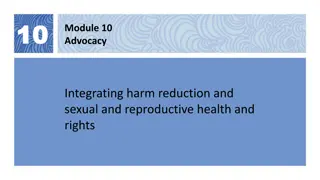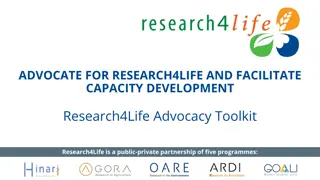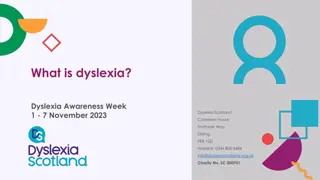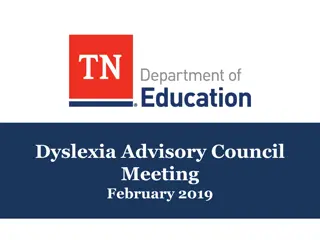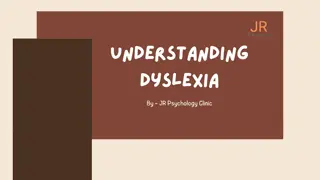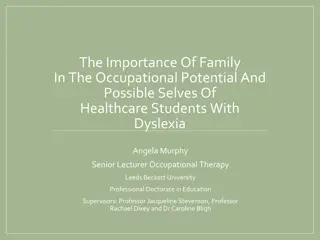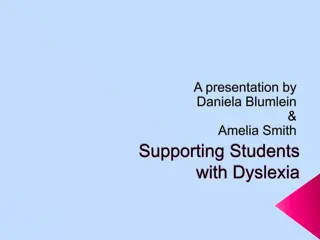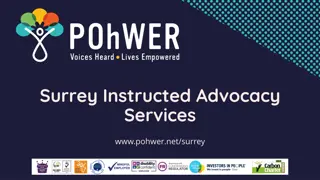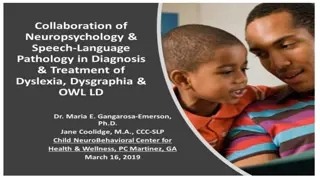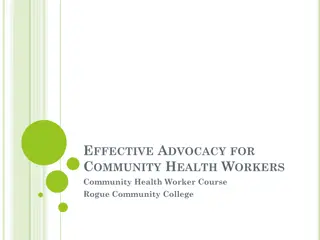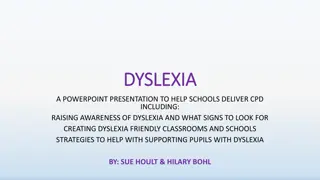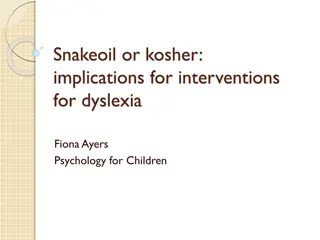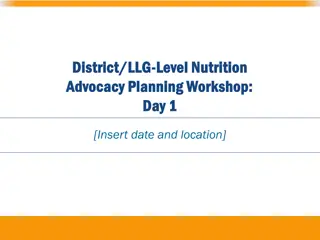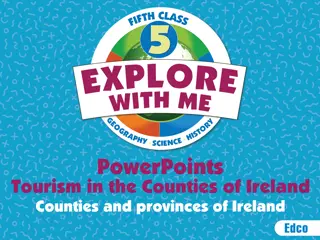Dyslexia Awareness and Advocacy in Ireland
Dyslexia Association of Ireland (DAI) presents information on dyslexia awareness, identification, challenges faced, and the need for better support, training, and resources. The presentation highlights the impact of dyslexia on individuals and the education system in Ireland, emphasizing the importance of early detection and intervention for students with dyslexia. Key issues such as under-identification, financial stress, and the impact of technology and COVID-19 on dyslexic individuals are discussed, drawing attention to the need for improved teacher training and mental health support. The DAI's efforts in lobbying, campaigning, providing assessments, training, and tuition services are also outlined.
Download Presentation

Please find below an Image/Link to download the presentation.
The content on the website is provided AS IS for your information and personal use only. It may not be sold, licensed, or shared on other websites without obtaining consent from the author. Download presentation by click this link. If you encounter any issues during the download, it is possible that the publisher has removed the file from their server.
E N D
Presentation Transcript
Dyslexia Association of Ireland Dyslexia Association of Ireland Presentation to Oireachtas Members Dyslexia Awareness Week Wednesday 6thOctober 2021, 1pm
Dyslexia Association of Ireland Dyslexia Association of Ireland The Dyslexia Association of Ireland (DAI) has a 50 year history of representing our members (children, young people and adults with dyslexia). Lobbying and Campaigning Information Service Assessment Service Training Tuition
What is Dyslexia? What is Dyslexia? Dyslexia is a specific learning difficulty affecting the acquisition of fluent and accurate reading and spelling skills, that occurs despite access to appropriate learning opportunities. Dyslexic difficulties occur on a continuum from mild to severe and affect approximately 10% of the population. People with dyslexia may experience greater stress and frustration as they endeavour to learn, resulting in heightened anxiety, particularly in relation to literacy acquisition. People with dyslexia may also have accompanying learning strengths.
Key Issues Key Issues 1. Identification of Dyslexia 2. Financial Stress 3. Teacher Training 4. Resources and Supports 5. Special Classes/Schools 6. Technology 7. Mental Health & Well-being 8. Covid Impact Informed by our Biannual National Survey, conducted in September 2021 761 parents and adults with dyslexia and 425 teachers (71% primary, 27% secondary, 2% special class/school)
1. Identification of Dyslexia 1. Identification of Dyslexia ACCESS TO ASSESSMENTS Only 23% of parents had dyslexia identified via the public system (e.g. NEPS) - the rest had to pay for a private assessment. 79% parents waited 2+ years to get dyslexia formally identified. 39% of parents waited 4+ years. 89% of parents agree that earlier dyslexia identification would have helped. 92% of teachers feel that all children with literacy difficulties should have access to free dyslexia assessment.
1. Identification of Dyslexia 1. Identification of Dyslexia UNDER-IDENTIFICATION 100% of teachers have students in their classes with potentially undiagnosed dyslexia - a third of these stated that they had 5+ undiagnosed students in this category. Only 57% of teachers reported that their school has a clear procedure if a child has suspected dyslexia. Only 15% of teachers said that their school has a formal strategy/policy on addressing and managing dyslexia.
1. Identification of Dyslexia 1. Identification of Dyslexia IMPACT OF ACCURATE IDENTIFICATION 91% of both parents and teachers report that having a child s dyslexia identified helps them to better support their learning needs. 55% of teachers feel that their students performances have improved since their dyslexia was identified 62% of parents feel that identification led to improved mental health. 61% of teachers state that their students confidence has improved since their dyslexia was identified. 90% of teachers feel that unidentified dyslexia damages children s self-esteem.
2. Financial Stress 2. Financial Stress COSTS OF BEING DYSLEXIC The average annual financial cost of dyslexia is 1,426 (assessment, tuition, computers/assistive technology). This is an increase of 9% based on our last survey in 2019 ( 1,334). ASSESSMENT AND SUPPORT 66% reported that the costs associated with addressing dyslexia have placed financial stress on the family. 64% reported that they were unable to obtain some resources or supports due to lack of funds. I had to buy a laptop which put me under financial strain. I am a single parent and it is costly, but I will do anything to make her life better.
3. Teacher Training 3. Teacher Training CONFIDENCE 64% of teachers are confident that they can teach a student with dyslexia. But only 23% of parents are confident that their child s teachers have a good understanding of what dyslexia is and the learning support needs of their child. INITIAL TRAINING During initial teacher education, only 18% of teachers received training on dyslexia. Only 3% of teachers felt that the level of pre-service training they received on dyslexia adequately prepared them for the classroom. When asked how much time during their initial teacher training was spent specifically on dyslexia, 54% said none, 25% said only one hour.
3. Teacher Training 3. Teacher Training IN-SERVICE TRAINING 58% of teachers have received some in-service training on dyslexia, however only 33% found that training was sufficient. 96% of teachers feel that they would benefit from further in-service training on dyslexia (identification, supports and technology).
Three Levels of Teacher Training Three Levels of Teacher Training Dyslexia Specialists Specialists trained to assess for dyslexia and support schools on best practice re support. Training for Few Enhanced Training Special Education Teachers trained in evidence-based targeted interventions. Training for Some Basic Training All teachers trained in dyslexia identification and good practices of classroom support. Training for All
Three Levels of Support Three Levels of Support Specialist Intervention: Individualised intensive intervention for more severe and enduring needs. Support for Few Targeted Support Targeted additional teaching support for those not responding to initial support. Support for Some Classroom Support Additional support in the classroom focused on areas of difficulty. Support for All
4. Resources and Supports 4. Resources and Supports INCONSISTENCY OF SUPPORT Only 40% of parents were satisfied with the level of support their child received from their school. 46% of teachers feel that they are currently providing adequate support for dyslexic students in their class. 60% parents reported difficulty accessing resources/supports. Only 44% of teachers feel that their school has good resources for supporting students with dyslexia. Only 2% of members were satisfied with the current level of support provided by the government to assist families dealing with dyslexia.
5. Special Classes/Schools 5. Special Classes/Schools Parents highlighted the quality of support, including enhanced teacher knowledge and a holistic understanding of dyslexia that supports self-esteem. His reading age came up five years in his first year in the reading school. For many parents it was simply not an option, despite literacy percentiles at 5th percentile or lower, as there was no reading school or class in their area. We live in Dublin 15 and have no reading unit/class or dyslexia supports. 85% of parents feel that children with significant dyslexia should be able to access the support they need in their own school. I do not feel that my child should have to attend a special school. Teachers in mainstream schools should be well trained so kids can stay in their school and not feel ostracised.
6. Technology 6. Technology LACK OF ACCESS TO TECHNOLOGY Only 29% of parents noted that their child was given technology supports. Only 10% of pupils were being supported with access to alternative formats (audio books and ebooks). Even when we got the technology teachers were not guided on what to do with it, or how to make use of it. DAI has been advocating for a review of the Assistive Technology Grant for many years, and calls on the Department to expedite that review. It took six months despite having all paperwork ready immediately, and then it was still disputed by the SENO.
7. Mental Health and Well 7. Mental Health and Well- -being being 98% of members agree that dyslexia assessment is very important to aid understanding and support positive mental health. 96% feel that having dyslexia can have a negative effect on a person s mental health, especially if undiagnosed and unsupported. Concerns about self-esteem, anxiety and mental health was the highest rated challenge noted by our members (69%).
8. Covid Impact 8. Covid Impact NEGATIVE IMPACT ON STUDENTS 58% of parents felt that their children are further behind in literacy due to remote learning during lockdown. 44% of teachers reported that dyslexic children were more severely affected than their non-dyslexic peers Both teachers and parents report significant drops in standardised test scores of literacy between 2019 and 2021 42% of parents felt that remote learning had a negative impact on their child s confidence and wellbeing He felt stupid, frustrated and very low in confidence. Often he was completely overwhelmed.
8. Covid Impact 8. Covid Impact OTHER IMPACTS It was during the first lockdown that I spotted the signs of dyslexia when I was home-schooling my child. Literacy improved because of one-to-one support by us [parents] and there was less pressure from homework, so my son started reading for pleasure for the first time in his life. Stress and anxiety level were dramatically improved as a result of not being in the school environment. The move online has resulted in teachers putting notes up online, so he does not need to take down information from the board and can work at his own pace. He felt way more confident as a result.
What do our members want? (1/2) What do our members want? (1/2) 91% want mandatory training on dyslexia for all teachers. 84% want extra time in exams to be available for students with dyslexia. 84% want access to free assessment for anyone with queried dyslexia. 82% want funding for dyslexia specialist posts. 82% want increased funding for assistive technology for dyslexic students. 76% want funding for additional Special Education Teachers.
What do our members want? (2/2) What do our members want? (2/2) 75% want mandatory policies in schools which outlines how they identify and support students with dyslexia. 73% want more reading classes/schools for children with severe dyslexia. 72% want school inspections to review the quality of supports for dyslexia. 71% want funding for evidence-based self-esteem programmes. 64% want funding for a public dyslexia awareness campaign. 62% want universal screening for dyslexia for all primary school students.
Key Messages for Oireachtas Members Key Messages for Oireachtas Members 1. We need to recognise the value of accurate and timely identification and support that should be equitably accessed and free at the point of need. 2. We need a more developed continuum of support for all students with dyslexia and more targeted and specialist support for those that need it. 3. This should be provided by teachers who are all trained to support children with dyslexia, with some providing more targeted & specialised support. 4. We need much stronger support encouraging the use of technology in our classroom and with exams that mirrors third level and the wider world. 5. Failure to do the above will further endanger children s mental health and well-being, already exponentially impacted by Covid restrictions. 6. Link with your Education Committee colleagues re Senior Cycle reform.







